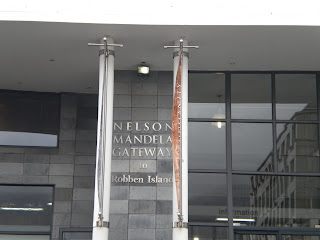Today's adventure took us through the city of Cape Town beginning with Bo-Kaap in the Malay Quarter. This area is the most colorful part of Cape Town and we learned that the Muslim faith is as old as Cape Town itself.
Next we visited the District Six Museum where we learned that, under an apartheid government, the multicultural District six was declared a White neighborhood in 1966. Noor was our guide and we purchased his book about his family, life, and what it was like to go through apartheid and come out the other side with forgiveness. This neighborhood was originally a diverse mix of subcultures; everyone in the district was forced out to their own townships or to the Cape Flats. Interracial families were required to separate because of skin color which meant that they had to request a permit from the police just to visit loved ones, including children. Just recently people have started to move back to the land that was striped from them. In the photo there are pictures of some of the original street signs and an aerial map of District six.
Lastly we went to the infamous Robben Island. We took the catamaran ferry across the choppy Atlantic Ocean; a roller coaster ride like no other! The swells were between 4-7 meters, I had to go out the port side to take pictures - thank goodness for sea-legs! While on our tour we were told stories of civil rights and social justice activists like Robert Sobukwe, Albert Luthulie, and (you all know of) Nelson Mandela. Robert Sobukwe was given the (worlds) smallest prison on the island for constructing a protest march that started as a small crowd at first, but because of the outcome, 20,000 people later joined in a peaceful protest that ended in police using machine guns to mow them down. The original protest was held because colored people were required to carry around a pass booklet when they were outside their designated areas and Sobukwe, as well as others, decided to walk to the police station without his. He was quickly arrested and charged. After serving his sentence here on the mainland, the Minister of Justice prolonged his sentence and sent him to Robben Island where he spent about six years in this single prison with no contact from others. When he was released in 1969, due to the aforementioned 20,000 people in the civil uprisings, he could not speak.
Other interesting facts: Robben Island was used as a place to house and treat Lepers and the mentally ill, then it was a defense station during WWII, and finally just for prison purposes - even though it was like a prison for lepers and the mentally ill back in the 1840's. Originally there were no trees on the island until 1890 when the British brought Eucalyptus trees which ruined the fresh water system, as a result fresh water must be shipped in. One good thing about the trees - the bird population has increased. There are about 129 species of bird on the island. In 1976 Robben Island had 1,500 political prisoners - the highest amount ever recorded. Robben Island was not just a prison during apartheid; it was a place where people became educated in the face of adversity. The educated taught the uneducated and many people came out of prison with degrees and skills because it was turned into a university of sorts.
I am in Moses Masemola's cell
Nelson Mandela's Holding Cell (above and below pic)
We walked throughout the prison and read the stories of prisoners and the struggles they endured, including Nelson Mandela. Although prisoners succumbed to brutal torture, they still believed in reconciliation - forgiveness and do not take revenge. A practice taught by Martin Luther King and Mahatma Ghandi. They call them the three M's because they all fought for the same thing: social justice.























